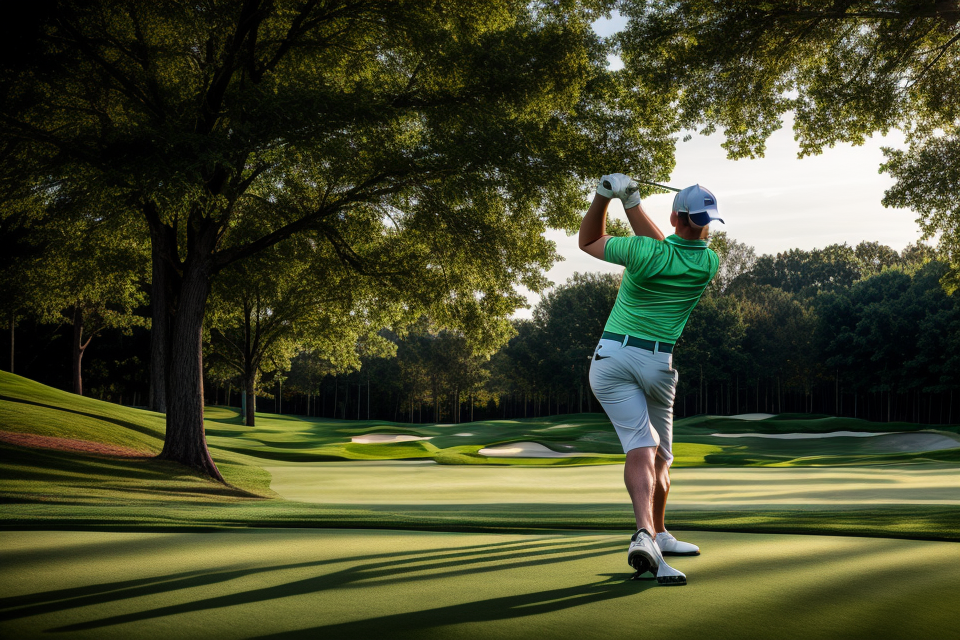
Are you tired of hitting the golf ball with less distance? Do you want to impress your friends with your long drives? Then you’ve come to the right place! In this article, we’ll be revealing the secrets of hitting a golf ball really far. With expert tips and techniques, you’ll be able to add yards to your shots and hit the ball with power and precision. Whether you’re a beginner or an experienced golfer, this guide has something for everyone. So grab your clubs and get ready to learn how to hit a golf ball far!
Understanding the Golf Swing
The Basics of a Good Golf Swing
A good golf swing is built on a foundation of proper technique, which includes a strong grip, a balanced stance, a smooth backswing, and a powerful downswing.
The Grip
The grip is the first point of contact between the golfer and the club, and it is crucial to set the tone for the entire swing. A correct grip ensures that the club moves in a smooth and controlled manner, and it helps to prevent errors that can lead to poor shots.
To achieve a good grip, the golfer should place the hands on the club, with the right hand on top and the left hand at the bottom. The fingers should be relaxed and slightly bent, and the club should be held lightly but firmly. The right hand should be aligned with the right shoulder, and the left hand should be aligned with the left shoulder.
The Stance
The stance is the position of the golfer’s feet and body during the swing. A good stance provides stability and balance, and it allows the golfer to make a smooth and powerful swing.
To achieve a good stance, the golfer should stand with the feet shoulder-width apart, with the left foot slightly ahead of the right foot. The knees should be slightly bent, and the weight should be distributed evenly on both feet. The hips should be positioned directly over the feet, and the torso should be tilted slightly forward.
The Backswing
The backswing is the movement of the club from the address position to the top of the swing. A good backswing sets the stage for a powerful downswing and helps to ensure that the ball is hit with precision and accuracy.
To achieve a good backswing, the golfer should begin by lifting the club away from the ball, keeping the arms and hands close to the body. The golfer should then rotate the shoulders and hips, bringing the club back towards the body in a smooth and controlled manner. The wrists should remain firm and straight, and the club should be held in a position parallel to the ground at the top of the swing.
The Downswing
The downswing is the movement of the club from the top of the swing to the ball. A good downswing unleashes the power of the swing and helps to ensure that the ball is hit with maximum distance and accuracy.
To achieve a good downswing, the golfer should begin by shifting the weight towards the left foot, preparing to transfer power to the shot. The golfer should then rotate the hips and shoulders, bringing the club down towards the ball in a smooth and controlled manner. The wrists should remain firm and straight, and the club should be held in a position parallel to the ground at impact. The golfer should then release the club through impact, allowing the ball to fly towards the target.
Warm-up and Stretching Exercises
Importance of a Proper Warm-up
A proper warm-up is essential to prepare the body for the physical demands of the golf swing. The warm-up should consist of light aerobic activity and dynamic stretching exercises to increase blood flow and activate the muscles used in the swing. This helps to prevent injury and improve performance.
Stretching Exercises for Golfers
There are several stretching exercises that are specifically designed for golfers. These exercises target the muscles used in the swing, such as the hips, legs, and back. By performing these stretches, golfers can improve their flexibility and range of motion, which can lead to more efficient and powerful swings.
Some of the most effective stretching exercises for golfers include:
- Hip Openers: These stretches target the hips, which are essential for a powerful and accurate swing. Examples include the butterfly stretch, figure four stretch, and pigeon stretch.
- Hamstring Stretches: Hamstring muscles are critical for the backswing and follow-through. Good stretching exercises for hamstrings include the seated hamstring stretch, standing hamstring stretch, and straddle stretch.
- Upper Body Stretches: The upper body is also essential in the golf swing, and stretches such as the shoulder roll, wrist circles, and neck stretches can help improve range of motion and prevent injury.
It is important to hold each stretch for 15-30 seconds and repeat 2-3 times. A proper warm-up and stretching routine should take about 10-15 minutes before starting to play.
The Role of Equipment
Choosing the Right Clubs
Choosing the right golf clubs is crucial to hitting a golf ball far. Different types of golf clubs are designed for specific shots and swing types, so it’s important to choose the right club for your game.
Factors to Consider When Choosing Clubs
When choosing golf clubs, consider the following factors:
- Your swing speed and power
- Your shot distance and accuracy requirements
- Your preferred shot shape (e.g. draw or fade)
- Your budget and personal preferences
Understanding these factors can help you select the best golf clubs for your game and improve your overall performance on the course.
Proper Club Fitting
The Importance of Proper Club Fitting
In golf, using the right equipment is crucial to achieving the desired results. Club fitting is an essential aspect of golf equipment that should not be overlooked. Proper club fitting ensures that the golfer uses a club that fits their swing and physical attributes, allowing them to hit the ball farther and straighter. A well-fitted club provides the golfer with better control over the ball, leading to more accurate shots and ultimately lower scores.
How to Get Your Clubs Fitted
To get your clubs fitted, you need to visit a professional club fitter or a golf store that offers club fitting services. During the fitting process, the fitter will assess your physical attributes, such as height, weight, and swing speed, to determine the right club specifications for you. They will measure your physical attributes and use that information to select the best shaft, grip size, and clubhead that suit your swing.
Additionally, the fitter will analyze your swing using a launch monitor or a swing analyzer to determine the right loft and shaft flex for your clubs. This information will help the fitter to create a custom-fit club that is tailored to your swing and physical attributes.
Once the fitting process is complete, the fitter will provide you with a list of recommended clubs and their specifications. You can then order the clubs directly from the fitter or from an online retailer. It is important to note that the fitting process may take several hours, and it may require multiple visits to complete. However, the benefits of having properly fitted clubs are worth the time and effort.
Developing a Powerful Swing
The Power Swing
The power swing is the foundation of hitting a golf ball far. To understand the mechanics of a powerful swing, it is important to break down the swing into three key elements: the takeaway, the backswing, and the downswing.
- Takeaway: The takeaway is the initial movement of the club away from the ball. To achieve a powerful takeaway, it is important to keep the club shaft parallel to the ground and to avoid lifting the hands off the club.
- Backswing: The backswing is the movement of the club from the takeaway to the top of the swing. To maximize power, it is important to keep the club shaft on a path that is slightly inside the target line during the backswing.
- Downswing: The downswing is the movement of the club from the top of the swing to the ball. To hit the ball far, it is important to accelerate the club through the ball and to maintain a strong, consistent grip pressure.
To increase power and distance, it is important to practice the power swing regularly and to focus on maintaining a smooth, consistent motion throughout the swing. Additionally, incorporating strength training exercises and using a lighter golf club can also help to increase power and distance.
Maintaining Balance and Control
Balancing Power and Control
When it comes to hitting a golf ball far, it’s important to strike a balance between power and control. Golfers who rely too heavily on power may find themselves losing control over their shots, resulting in slices or hooks that veer off course. On the other hand, golfers who focus too much on control may struggle to generate the power needed to hit the ball long distances.
Maintaining Proper Form and Technique
Proper form and technique are essential for maintaining balance and control in your swing. Golfers should focus on keeping their head still and their eyes on the ball throughout the swing, using their legs and core to generate power rather than their arms. It’s also important to maintain a smooth, fluid motion throughout the swing, avoiding any jerky or sudden movements that can disrupt balance and control.
One helpful tip for maintaining balance and control is to practice swinging with a weighted club or training aid. This can help golfers develop the muscle memory and muscle control needed to maintain proper form and technique even as they swing faster and harder.
Overall, striking the right balance between power and control requires practice, patience, and a willingness to experiment with different techniques and approaches until you find what works best for you.
Mental Game
Developing a Winning Mindset
Developing a winning mindset is crucial for hitting a golf ball far. Here are some tips to help you develop a winning mindset:
- Positive Visualization Techniques: Visualization is a powerful tool that can help you improve your golf game. Spend a few minutes each day visualizing yourself hitting the perfect shot. Close your eyes and imagine the scene in detail, including the feel of the club in your hands, the sound of the ball being struck, and the ball flying towards the target.
- Mental Preparation Strategies: Preparation is key to performing well on the golf course. Develop a pre-shot routine that helps you get into the right mindset. This might include taking a few deep breaths, visualizing your shot, and repeating a positive mantra to yourself. Make sure you also take time to warm up and practice your swing before each round.
By developing a winning mindset, you can improve your focus, reduce stress and anxiety, and increase your confidence on the golf course. With a positive attitude and a strong mental game, you’ll be well on your way to hitting the golf ball far and straight.
Handling Pressure and Nerves
As a golfer, you may find yourself facing pressure and nerves when you step up to the tee or approach a crucial shot. However, managing these emotions is key to hitting a golf ball far. Here are some tips for handling pressure and nerves on the golf course:
Tips for Staying Calm Under Pressure
- Take slow, deep breaths: Take a few deep breaths before you address the ball, and remind yourself to breathe slowly and steadily throughout your swing.
- Visualize success: Imagine yourself making a successful shot, and focus on the positive outcome.
- Use positive self-talk: Encourage yourself with positive affirmations, such as “I can do this” or “I am a great golfer.”
- Focus on the process, not the outcome: Concentrate on executing the shot rather than worrying about the end result.
- Use physical sensations to ground yourself: Ground yourself by focusing on the physical sensations of the shot, such as the feel of the club in your hands or the motion of your swing.
Managing Nerves on the Golf Course
- Acknowledge your nerves: Recognize that nerves are a natural part of the game, and that even the best golfers feel nervous at times.
- Practice relaxation techniques: Try techniques such as visualization, deep breathing, or progressive muscle relaxation to help calm your nerves.
- Take breaks: If you feel overwhelmed, take a break and come back to the shot when you feel more composed.
- Focus on your strengths: Remind yourself of your strengths as a golfer, and trust in your abilities.
- Keep things in perspective: Remember that golf is just a game, and that the most important thing is to have fun and enjoy the experience.
Practice and Training
Building a Training Program
Creating a Personalized Training Plan
A personalized training plan is crucial for building a successful training program. This plan should take into account your current skill level, strengths, weaknesses, and goals. By identifying these factors, you can create a training program that is tailored to your needs and will help you improve your golf game.
To create a personalized training plan, start by assessing your current skill level. Take note of your strengths and weaknesses, and identify areas where you need improvement. Next, set specific, measurable, achievable, relevant, and time-bound (SMART) goals. These goals should be challenging but realistic, and should focus on specific aspects of your game that you want to improve.
Once you have your personalized training plan in place, it’s important to stick to it. Consistency is key when it comes to improving your golf game, so make sure you schedule regular practice sessions and follow your training plan as closely as possible.
Regular Practice Sessions
Regular practice sessions are essential for building a successful training program. The more you practice, the more you’ll be able to improve your technique, build muscle memory, and develop your overall game.
It’s important to schedule regular practice sessions into your weekly routine. Set aside specific times each week when you can dedicate yourself to practicing your golf swing, hitting balls on the driving range, and working on your short game. Consistency is key, so try to schedule your practice sessions at the same time each week to help build a routine.
During your practice sessions, focus on the specific aspects of your game that you want to improve. If you’re having trouble hitting the ball far, spend extra time working on your full swing. If you’re struggling with your short game, spend more time practicing your chipping and putting.
In addition to practicing the specific aspects of your game that you want to improve, it’s also important to practice good overall technique. Make sure you’re using proper form and technique when hitting your shots, and take the time to practice your swing in slow motion to help ingrain good habits.
By building a personalized training plan and regularly scheduling practice sessions, you’ll be well on your way to hitting the ball far and improving your overall golf game.
Focus on Fundamentals
When it comes to hitting a golf ball far, it’s important to focus on the fundamentals. Mastering the basics of your swing will help you build a solid foundation and improve your overall technique. Here are some tips for focusing on fundamentals:
Importance of Mastering the Basics
Mastering the basics of your golf swing is crucial for hitting the ball far. By focusing on the fundamentals, you’ll develop a solid foundation that will help you improve your technique and increase your distance off the tee. This includes developing a smooth and consistent swing, learning how to properly set up to the ball, and developing a feel for the golf club.
Practice Drills for Improving Fundamentals
To improve your fundamentals, it’s important to practice regularly and focus on specific drills that will help you develop your skills. Here are some practice drills to help you improve your fundamentals:
Alignment Drill
One of the most important fundamentals of your golf swing is alignment. To improve your alignment, try this drill:
- Set up to the ball with your feet shoulder-width apart and your knees slightly bent.
- Place a club behind your shoulder and check that your shoulders are parallel to the target line.
- Make a practice swing and check your alignment in the mirror or with a swing analyzer.
- Repeat this process until you feel comfortable with your alignment.
Ball-Striking Drill
Another important fundamental is ball-striking. To improve your ball-striking, try this drill:
- Make a practice swing and try to strike the ball on the sweet spot of the club.
- Repeat this process, focusing on hitting the ball solidly and with confidence.
Swing Speed Drill
Swing speed is another important fundamental that can help you hit the ball far. To improve your swing speed, try this drill:
- Make a practice swing, focusing on using your legs and hips to generate speed.
- Use a swing speed machine or radar gun to measure your swing speed and track your progress.
By focusing on these fundamental practice drills, you’ll be well on your way to hitting the ball far and consistently on the golf course.
Tracking Progress and Analyzing Performance
One of the most effective ways to improve your golf game is by tracking your progress and analyzing your performance. This allows you to identify areas where you need to improve and make adjustments to your technique. Here are some tips on how to track your progress and analyze your performance:
- Keeping Scorecards and Tracking Progress
Keeping scorecards is a great way to track your progress over time. Make sure to record your scores for each hole, as well as any notable shots or putts. This will give you a clear picture of your strengths and weaknesses, and help you identify areas where you need to focus your practice.
- Analyzing Performance to Identify Areas for Improvement
Once you have collected data on your performance, it’s time to analyze it and identify areas for improvement. Look for patterns in your scores and shots, and try to identify any recurring issues or weaknesses. For example, if you consistently struggle with long drives, you may need to focus on improving your swing technique or using a different type of club.
Another important aspect of analyzing your performance is tracking your stats. This includes metrics such as driving distance, greens in regulation, and putting average. By tracking these stats, you can get a better understanding of your overall game and identify areas where you need to improve.
- Making Adjustments to Your Technique
Once you have identified areas for improvement, it’s time to make adjustments to your technique. This may involve working with a golf coach or using video analysis to identify any flaws in your swing. It’s important to be patient and take a gradual approach, as making significant changes to your technique can take time and practice.
Overall, tracking your progress and analyzing your performance is a crucial part of improving your golf game. By identifying areas for improvement and making adjustments to your technique, you can become a better golfer and hit the ball further down the fairway.
FAQs
1. What is the importance of using the right equipment for hitting a golf ball far?
The right equipment is crucial for hitting a golf ball far. Using the wrong equipment can lead to incorrect swing mechanics, which can cause the ball to travel shorter distances. Therefore, it is essential to invest in high-quality clubs that fit your body type and swing style.
2. How should I position my body when hitting a golf ball far?
Your body position is critical when hitting a golf ball far. You should set up with your feet shoulder-width apart, with your weight evenly distributed on your feet. Your knees should be slightly bent, and your hands should be in front of your body. Keep your head down, and your eyes focused on the ball, and make sure your body is in balance during the swing.
3. What is the proper technique for hitting a golf ball far?
The proper technique for hitting a golf ball far involves a smooth, rhythmic swing that is centered on your body’s core rotation. Your backswing should be slow and controlled, and your downswing should be explosive and powerful. As you swing, focus on keeping your head down, your eyes on the ball, and your weight shifted to your front foot. Avoid lifting your head or swaying from side to side during the swing.
4. How can I improve my distance off the tee?
To improve your distance off the tee, focus on using a full swing with a smooth, accelerating tempo. Keep your head down, and your eyes on the ball, and use your legs and core to generate power. Avoid using your arms and hands to swing the club, as this can lead to an unbalanced swing. Practice hitting balls off the tee to develop your power and distance.
5. What are some common mistakes that can prevent me from hitting a golf ball far?
Common mistakes that can prevent you from hitting a golf ball far include using improper technique, using the wrong equipment, and not warming up properly before playing. Other mistakes include taking too many practice swings, not keeping your head down during the swing, and not using your legs and core to generate power. By avoiding these mistakes, you can improve your chances of hitting the ball far and straight.


